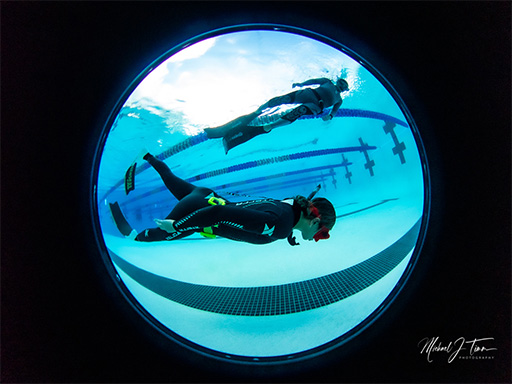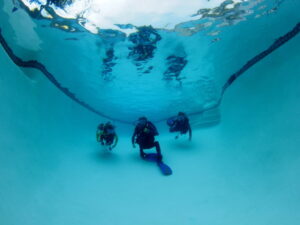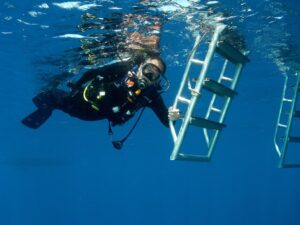A Guide to Every Freediving Discipline in Competitive Freediving
Freediving is a fun way to explore the ocean, but it’s also a competitive sport in which freedivers compete to reach the deepest depths or achieve the longest breath holds. Competitions are held around the world for each of the freediving disciplines.
Every discipline requires the freediver to use a specified technique or gear configuration.
Let’s break down each of the freediving disciplines for both pool and open water competitions.
Remember: Even if you’re not-so-interested in winning medals or breaking world records, a freediving competition is a fantastic way to develop your skills, meet fellow freedivers, and have fun!

Freediving Disciplines: Pool vs. Open Water
Freediving disciplines can be broken down into one of two categories:
- Pool Disciplines
- Open Water Disciplines
Pool Disciplines
Pool disciplines are just as they sound: they refer to freediving techniques that are used in a pool or confined water setting.
Pool-based freediving competitions are popular in landlocked areas where local freedivers can’t access the ocean. They’re also popular in very cold regions where it’s more difficult to dive in the ocean.
Pool disciplines include:
- Static (STA)
- Dynamic No Fins (DNF)
- Dynamic (DYN)
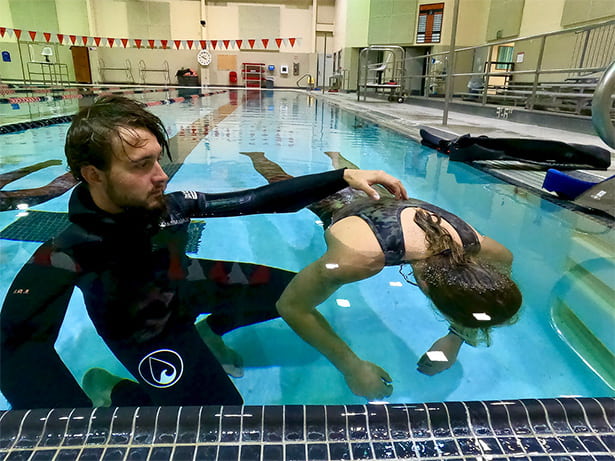
Static (STA)
Static apnea (STA) is when the freediver keeps his or her face submerged in water and holds a breath for as long as possible. The freediver may either float in the water (while being positively buoyant) or stand in the water. The key is that you’re not supposed to be moving in the water–hence the term, “static.”
This is the only freediving discipline that’s measured in time.
Some competitive freedivers use oxygen when they’re attempting to break world records in static freediving. They’ll breathe 100% oxygen (as opposed to air) for up to half an hour before their breath hold attempt. By breathing oxygen, the freediver enhances their blood oxygen saturation level, which helps them hold the breath longer.
World records have been broken with and without the use of oxygen!
| Men | Branko Petrovic (Serbia) | No O2 | 11:54 | 2014 |
| Women | Natalia Molchanova (Russia) | No O2 | 9:02 | 2013 |
| Men | Budimir Sobat (Croatia) | with O2 | 24:11 | 2018 |
| Women | Karoline Mariechen (Brazil) | with O2 | 18:32 | 2009 |
Dynamic No Fins (DNF)
Dynamic No Fins apnea is when the freediver travels in a horizontal position underwater, attempting to cover the greatest distance possible while only using the arms and legs to propel through the water. No propulsion aids are permitted in DNF.
DNF is probably the most technical of all freediving disciplines. It’s also the most natural of the disciplines that measure distance.
| Men | Mateusz Malina (Poland) | 244m (801 ft) | 2016 |
| Women | Magdalena Solich-Talanda (Poland) | 191m (627 ft) | 2017 |
Dynamic (DYN)
Dynamic apnea is when the freediver travels in a horizontal position underwater while attempting to cover the greatest possible distance. The freediver uses bi-fins or a monofin for propulsion, but arm movements are prohibited. Most freedivers prefer to practice this discipline in a 50m pool so they can do fewer turns and save energy.
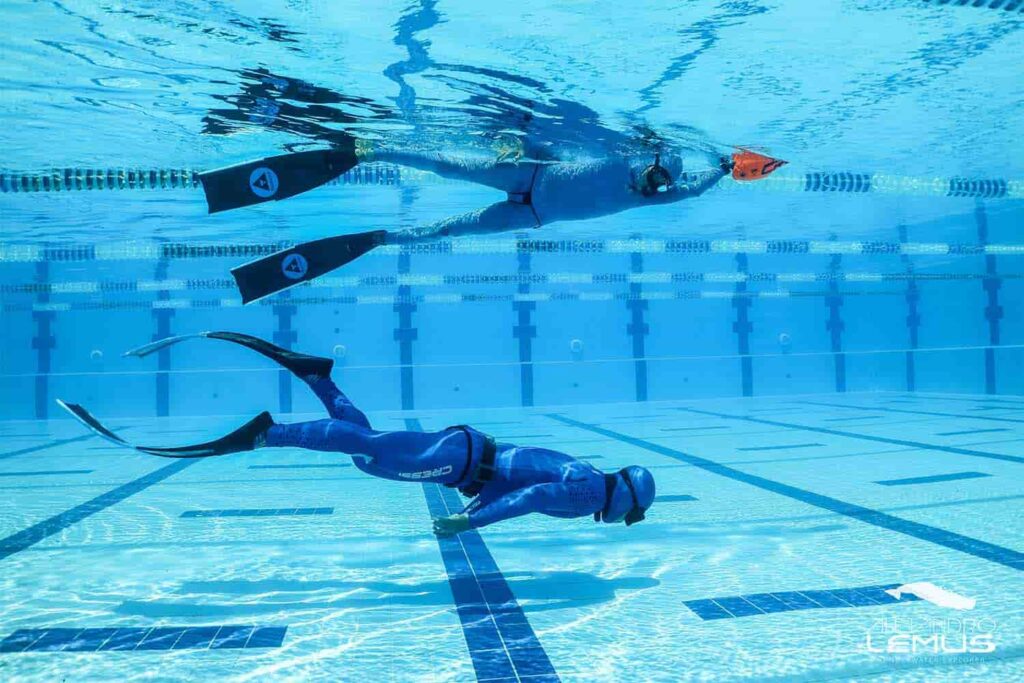
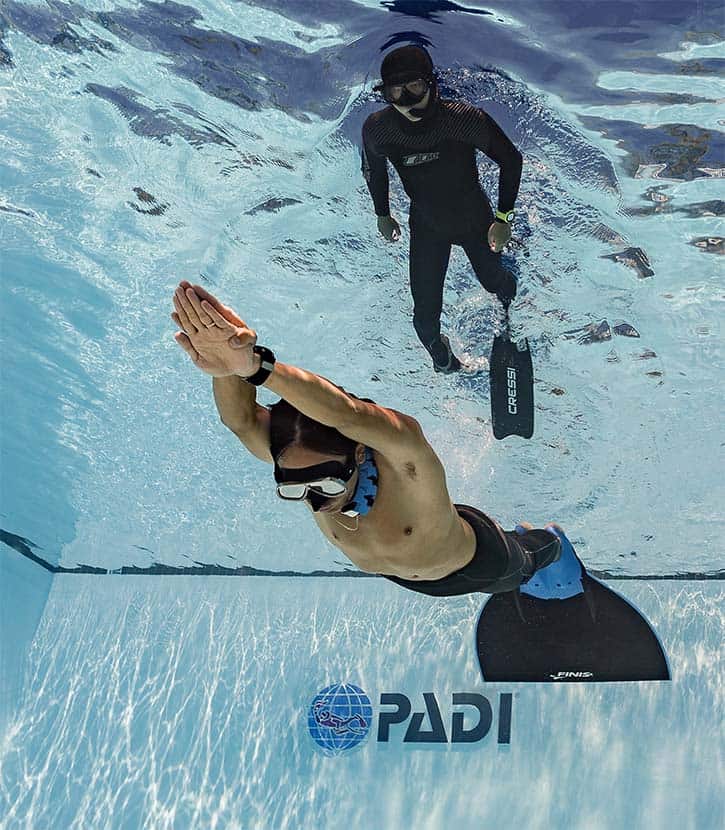
Dynamic apnea is the most common of the freediving disciplines that measure distance.
| Men | Giorgos Panagiotakis (Greece) | 300m (984 ft) | 2016 |
| Women | Magdalena Solich-Talanda (Poland) | 257m (843 ft) | 2019 |
Open Water Disciplines
Open water disciplines are those that are practiced in a true marine environment. That may include the ocean, or a lake, quarry, or cenote.

Constant Weight (CWT)
Constant weight freediving is the most common and practiced discipline among freedivers. In CWT, the freediver descends and ascends vertically along the rope using fins and/or arm movements. The freediver cannot change weight and is only permitted to touch or pull the rope once–when turning at the target depth and preparing to ascend.
| Men | Alexey Molchanov (Russia) | 131m (429 ft) | 4:10 | 2021 |
| Women | Alenka Artnik (Slovenia) | 120m (387 ft) | 3:32 | 2021 |
Constant Weight No Fins (CNF)
In CNF, the freediver descends and ascends in the water using only his or her own muscle strength. The freediver cannot use propulsion equipment, pull on the rope, or change weight.
CNF is considered the most difficult of the three depth disciplines.
| Men | William Trubridge (New Zealand) | 102m (335 ft) | 4:14 | 2016 |
| Women | Alessia Zecchini (Italy) | 74m (243 ft) | 3:10 | 2021 |
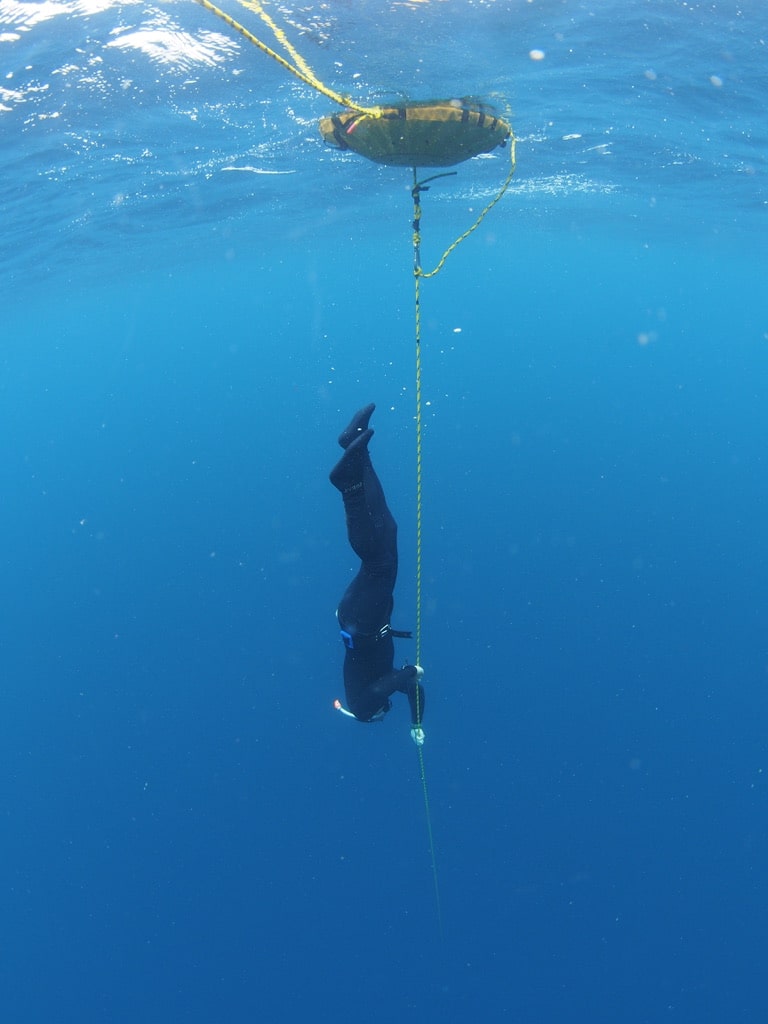
Free Immersion (FIM)
In free immersion, the freediver dives underwater without the use of propulsion equipment. They pull on the rope during the descent and ascent. The freediver can use either the “head down” or “head up” position.
Free immersion is the depth discipline with the purest sensations. That’s because each rope pull is powerful–so the water passing over the body is moving at a very high speed. It’s one of the most relaxing freediving disciplines, and is also one of the easiest to learn. FIM is also a great way to practice equalization and relaxation, while moving as slow or as fast as needed.
| Men | Alexey Molchanov (Russia) | 126m (413 ft) | 4:30 | 2021 |
| Women | Alessia Zecchini (Italy) | 101m (331 ft) | 3:50 | 2021 |
Variable Weight (VWT)
In VWT, the freediver descends with the help of a ballast weight/sled and then ascends with the help of bi-fins, monofins, arm/leg movements, and/or pulling on the rope.
| Men | Stavros Kastrinakis (Greece) | 146m (479 ft) | 3:33 | 2015 |
| Women | Nanja Van Den Broek (Netherlands) | 130m (427 ft) | 3:00 | 2015 |
No-Limits (NLT)
No-Limits is the most risky and extreme freediving discipline. The freediver descends with the help of a ballast weight and ascends by any method of choice.
For the descent, the freediver often uses a streamlined sled to descend rapidly. For the ascent, the freediver may use an inflatable lift bag, a balloon system, or an inflatable vest.
What makes this discipline so risky is that freedivers often descend extreme depths and must know how to manage the extraordinary pressure changes, and also the great distance they’ll travel from fresh air.
No-Limits freediving received a lot of publicity when it was featured in the movie, Big Blue.
Skandalopetra
Last, but not least, is the ancient freediving discipline known as Skandalopetra.
Skandalopetra is an ages-old discipline that traces its roots back to the sponge fishermen of Ancient Greece. It’s also the only team event in competitive freediving.
One of the athletes in a team of two will descent holding on to a stone, (usually a granite or marble slab, weighting between 8 to 14kg), attached to a rope. When the diver reaches the desired depth, his or her partner on the surface starts hauling the diver back up to the surface by muscle power. Traditionally, no mask, wetsuits or fins are allowed. However, the diver may use a nose clip and fluid goggles.
Which Freediving Discipline is Right for Me?
How do you know which freediving discipline is most enjoyable for you?
There’s only one way to know: take a freediving course and spend some time with your instructor experimenting with a variety of different disciplines.
The local freedivers in your area may also be an excellent resource!

